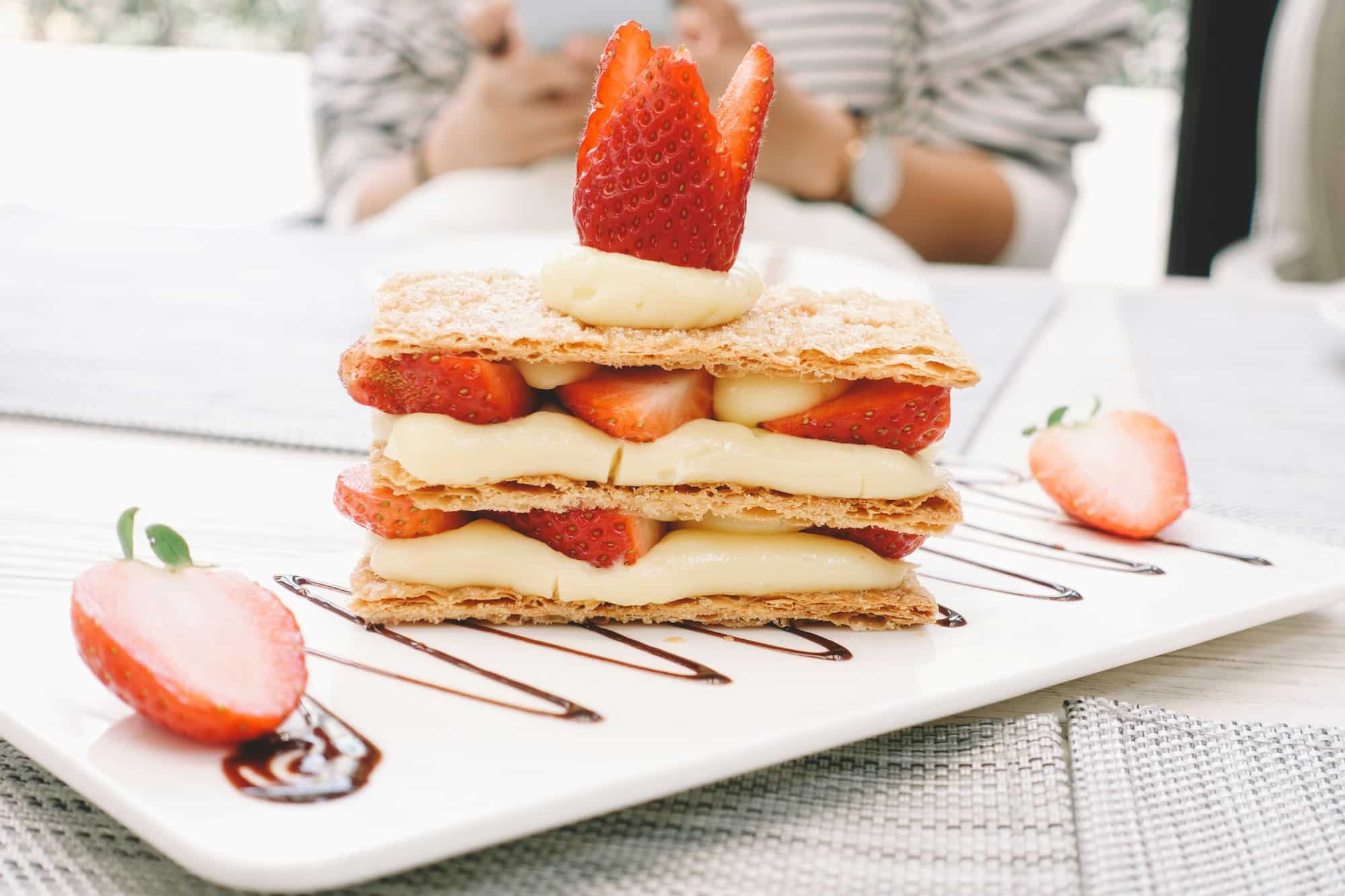What’s the Secret to a Perfectly Layered Mille-Feuille with Vanilla Pastry Cream?

In the world of pastry, there’s a particular dessert that’s renowned for its delicate layers and creamy filling – the mille-feuille. Originating in France, the name translates to ‘thousand sheets’, which perfectly describes its intricate construction. At its heart lies a simple combination of ingredients – puff pastry, cream, sugar, and vanilla. But creating a mille-feuille that’s airy, luscious, and perfectly layered is no ordinary task. So, what’s the secret? Let’s unravel this culinary mystery in the sections below.
The Role of High-Quality Ingredients
In any recipe, the quality of ingredients plays a crucial role in determining the final outcome. In the case of mille-feuille, this couldn’t be more true. High-quality butter, milk, eggs, vanilla, and sugar can significantly enhance the flavors of your dessert and take it from good to outstanding.
A lire aussi : What’s the Secret to a Flavorful Seafood Paella with Saffron and Fresh Shellfish?
Butter
The core of a mille-feuille is its puff pastry. The secret to achieving a light, buttery, and flaky pastry lies in using good quality butter. Opting for unsalted, high-fat content butter can provide your pastry with a rich flavor and delicate texture.
Milk and Sugar
The mille-feuille’s filling, a classic vanilla pastry cream, or custard, is a harmony of milk, sugar, and egg yolks. The quality of milk and sugar will have a direct impact on your cream’s taste, texture, and color. For the most sumptuous custard, we recommend using whole milk and granulated sugar, which renders a creamy, sweet custard with a beautiful golden hue.
A découvrir également : What’s the Technique for the Perfect Eggs Benedict with Homemade Hollandaise?
Vanilla
Vanilla is the star ingredient in the filling. The quality and type of vanilla you use can drastically change the flavor profile of your cream. Try to use real vanilla beans or high-quality vanilla extract to give your custard an authentic, rich vanilla flavor.
The Art of Baking Puff Pastry
Baking puff pastry for mille-feuille requires a bit of technique to achieve the desired layers and texture. The aim is to bake the puff pastry such that it rises evenly, crispy on top, but still delicate and airy inside.
Firstly, you’ll need to roll out your puff pastry thinly, then cut it into the desired shape. The pastry will be baked in two stages – first without sugar, then with a dusting of sugar on top to achieve that beautiful caramelized surface.
One trick that professional bakers use is to place a baking sheet on top of the pastry during the initial baking phase. This helps the puff pastry to rise evenly, creating those desirable, uniform layers. After about 15 minutes in the oven, remove the top baking sheet and add a thin layer of granulated sugar. Put the sugared pastry back into the oven and keep a close eye, as it will caramelize quickly.
Mastering the Vanilla Pastry Cream
The vanilla pastry cream, or custard, is essentially the soul of the mille-feuille. It’s a rich, creamy filling that balances the crispy puff pastry layers. The secret lies in achieving a creamy texture without it being too runny, and a sweet vanilla flavor that’s not overpowering.
In a saucepan, you’ll start by heating the milk and half the sugar. Meanwhile, whisk the egg yolks with the remaining sugar until they turn a pale yellow color. At this point, add in the flour and cornstarch, which will act as thickeners. Once the milk is hot, slowly temper it into the egg mixture. The key here is to add the milk gradually while whisking continually to avoid curdling the eggs.
Now it’s time to cook the custard. Pour the mixture back into the saucepan and cook on medium heat until it thickens. Off the heat, add the butter and vanilla, stirring until fully incorporated. The end result? A lusciously creamy, sweet vanilla pastry cream that’s ready to fill your mille-feuille.
Assembling the Mille-Feuille
Assembly is the final step in creating a mille-feuille. This is where all your hard work comes into fruition, as you layer puff pastry and vanilla pastry cream to create a dessert worthy of a Parisian patisserie.
Start by slicing the baked puff pastry rectangles in half, creating a top and bottom layer. Then, spread a generous amount of the cooled vanilla pastry cream on the bottom layer. Carefully place the top layer of puff pastry on the cream, gently pressing down to secure it.
For a traditional mille-feuille, repeat this process, adding another layer of pastry cream and a final layer of puff pastry. The classic mille-feuille features three layers of puff pastry and two layers of cream, but feel free to create your own variations. Dust the top with powdered sugar or a glazed icing for a touch of sweetness and a professional finish.
Creating a mille-feuille with vanilla pastry cream is a labor of love, but the result is absolutely worth it. With high-quality ingredients, careful baking, and a little bit of technique, you’ll be able to create a dessert that’s delightfully crisp, creamy, and perfectly layered.
Perfecting the Mille-Feuille’s Signature Layers
Creating the signature layers in a mille-feuille requires a combination of finesse, patience, and technique. It’s all about nailing that perfect balance between the crispy puff pastry and the creamy vanilla pastry cream.
Your puff pastry should be rolled out thin, cut into equal rectangles, and baked until it’s golden and crispy. Once it has cooled, slice each piece in half horizontally with a sharp knife, creating two thinner layers. This might feel a little daunting, but don’t worry – practice makes perfect.
Next, it’s time to layer your puff pastry with the vanilla pastry cream. Start by spreading a layer of cream onto the bottom half of your puff pastry. The cream should be cooled to room temperature to prevent it from melting. It should also be thick enough to hold its shape when spread, but not so thick that it’s difficult to work with.
Place the top half of the puff pastry on the cream filling, gently pressing down to make sure it’s secure. Repeat this process until you’ve layered all your puff pastry and cream. The classic mille-feuille features three layers of pastry and two layers of cream, but don’t be afraid to experiment with more layers if you’re feeling adventurous.
To finish off your mille-feuille, dust the top layer with powdered sugar or a glazed icing for a bit of extra sweetness and a professional touch.
Conclusion: The Pinnacle of Pastry Perfection
Mastering the art of the mille-feuille is a rewarding journey for any baking enthusiast. It’s not just about producing a beautiful dessert – it’s also about the satisfaction that comes from learning to work with delicate puff pastry, creating luscious vanilla pastry cream, and watching those layers come together into one harmonious dessert.
Remember, the key to a perfectly layered mille-feuille lies in using high-quality ingredients, baking your puff pastry with care, and taking your time to create a smooth, creamy filling. Don’t fret if your first mille-feuille isn’t perfect – like any skill, it takes practice to master.
Creating a mille-feuille with vanilla pastry cream truly is a labor of love, but the result is a dessert that’s incredibly satisfying – both to the eyes and to the palate. Its combination of crisp layers and creamy filling is a delight to savor, and a testament to the magic of pastry making. So roll up your sleeves, gather your ingredients, and start your journey to making the perfect mille-feuille. With a bit of patience and practice, you’ll be creating this classic French dessert like a professional patissier in no time.
